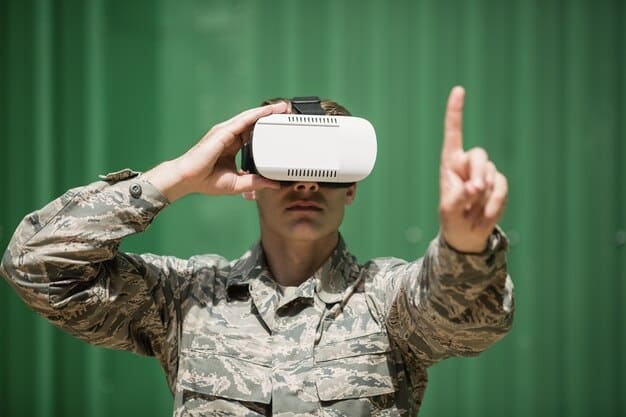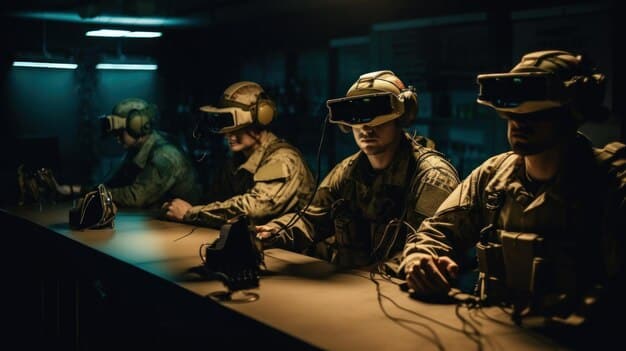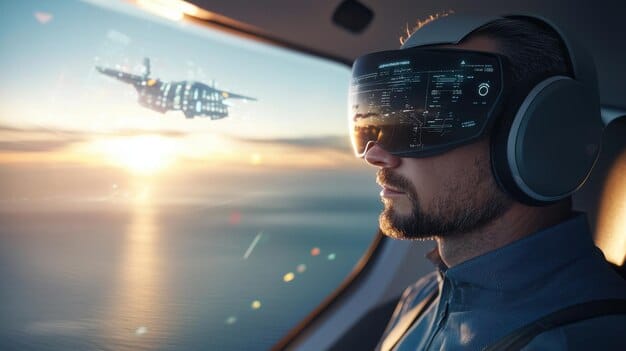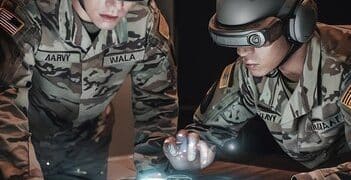US Military’s VR Combat Training: The Future of Warfare

The US military extensively employs virtual reality (VR) to revolutionize combat training, offering immersive, cost-effective, and adaptable environments that allow service members to hone critical skills, rehearse complex missions, and prepare for diverse operational scenarios without physical risk.
In a world rapidly transformed by technological advancements, the tools and methodologies for military readiness must evolve continuously. Few innovations hold as much transformative potential for modern armed forces as virtual reality. But how is the US military using virtual reality for combat training, and what does this mean for the future of warfare?
The Dawn of Digital Battlefields: VR’s Emergence in Military Training
The concept of using simulated environments for military training is not new, tracing its roots back to early flight simulators. However, the advent of sophisticated virtual reality technology has propelled this practice into an entirely new dimension. VR offers an unparalleled level of immersion, allowing warfighters to step into hyper-realistic digital worlds that mirror the complexities and stresses of actual combat scenarios.
Initially, military simulations were often expensive, cumbersome, and limited in their fidelity. They required dedicated physical spaces and complex machinery, making them difficult to deploy widely or adapt quickly. Virtual reality, leveraging advancements in computing power, graphics processing, and haptic feedback, has overcome many of these limitations. Today, VR systems are becoming more portable, affordable, and capable of generating incredibly detailed and dynamic environments, making them an increasingly attractive solution for training across all branches of the US military.
The early adoption phases focused on proving the technology’s effectiveness in enhancing traditional training methods. Rigorous testing and evaluation by military researchers and strategists demonstrated VR’s ability to not only replicate physical training but also to provide unique benefits that traditional methods could not, such as safer rehearsal of dangerous maneuvers or the ability to experience rare and unpredictable combat situations repeatedly.
Beyond the Firing Range: Expanding Training Horizons
Virtual reality enables training that extends far beyond the traditional firing range or combat zone. It allows for the simulation of complex geopolitical situations, urban warfare, disaster relief operations, and even sensitive diplomatic engagements. This breadth of application is crucial for preparing service members for the multifaceted challenges they face in modern conflicts, which often involve non-linear engagements and require a wide range of skills beyond direct combat.
Consider the benefits for special operations forces, who often need to rehearse highly sensitive and dangerous missions without any risk of compromise or injury. VR provides a secure, repeatable environment where every step of a mission, from infiltration to extraction, can be practiced, refined, and analyzed. This iterative process of training and feedback is fundamental to achieving high levels of operational proficiency and reducing real-world risks.
The US military is leveraging VR not just for individual skill development but also for unit-level and multi-unit training. This allows for seamless integration of different military branches and allied forces into a shared virtual battlespace, fostering better communication, coordination, and understanding of complex joint operations before they are carried out in the field.
The continuous evolution of VR hardware and software, coupled with the military’s increasing investment in these technologies, signals a long-term commitment to integrating virtual reality as a core component of its training strategy. This commitment reflects a recognition that preparing for tomorrow’s threats requires embracing today’s most advanced technologies.
Key Benefits of VR for Military Training
The adoption of VR in military training is driven by several compelling advantages:
- Enhanced Realism and Immersion: VR creates highly believable environments that engage multiple senses, making training more effective and memorable.
- Cost-Effectiveness: Simulating expensive or dangerous scenarios in VR significantly reduces costs associated with fuel, ammunition, wear and tear on equipment, and personnel travel.
- Safety and Risk Reduction: Trainees can practice high-risk maneuvers or engage in hazardous scenarios without any physical danger. Mistakes become learning opportunities rather than catastrophic failures.
- Repeatability and Customization: Scenarios can be repeated infinitely, altered on the fly, and tailored to individual or unit needs, allowing for focused training on specific weaknesses or complex situations.
- Objective Performance Measurement: VR systems can track and analyze trainee performance with precision, providing objective data for feedback and improvement.
This comprehensive set of benefits underscores VR’s pivotal role in shaping a more agile, resilient, and highly prepared fighting force.
Navigating the Virtual Terrain: Specific Applications Across Branches
Each branch of the US military has unique training requirements, and VR is being adapted to meet these specific needs, demonstrating its versatility and broad applicability. From pilots rehearsing intricate maneuvers to infantry practicing urban combat, VR is becoming an indispensable tool.
The Army, for instance, has embraced VR for ground combat training. Soldiers can navigate virtual terrains, identify threats, practice target acquisition, and engage in squad-level tactics within diverse environments, from arid deserts to dense urban sprawls. This capability is critical for preparing forces for asymmetrical warfare scenarios, where traditional battlefields are rare and adaptation is key. The Synthetic Training Environment (STE) is a prime example of the Army’s holistic approach to integrating live, virtual, and constructive training capabilities, with VR at its heart.
For the Navy and Marine Corps, VR offers innovative ways to train for maritime operations, amphibious assaults, and shipboard emergencies. Sailors and Marines can practice damage control, navigate complex ship layouts, or rehearse coordinated landing operations, all within a safe, controlled virtual environment. The precision required for these operations makes VR an ideal medium for iterative practice and skill refinement. VR also plays a significant role in medical training for corpsmen, allowing them to practice complex trauma care procedures in high-stress, realistic virtual settings.

Air Force and Space Force: Mastering the Skies and Beyond
The Air Force has a long history with simulation, and VR is the next evolution. Pilots are using VR to enhance flight training, simulating a vast array of combat scenarios, from dogfights to close air support missions. The ability to practice emergency procedures and high-stress situations without physical risk is invaluable. VR also allows for the simulation of new aircraft systems and weapon platforms before they are physically available, accelerating pilot readiness.
The nascent Space Force is also exploring VR for training its guardians. As the domain of space becomes increasingly contested, the ability to simulate satellite operations, space domain awareness, and orbital mechanics in a virtual environment is paramount. VR can help guardians understand complex spatial relationships, operate advanced systems, and respond to hypothetical threats in the unique environment of space.
Medical and Maintenance Training: Precision and Practicality
Beyond combat, VR is also revolutionizing military medical training. Surgeons and medics can practice complex procedures on virtual patient models, simulating everything from battlefield trauma care to routine surgical interventions. This hands-on, risk-free practice is crucial for developing the muscle memory and decision-making skills necessary in high-pressure medical situations. The fidelity of these simulations allows for the replication of realistic physiological responses, providing invaluable learning experiences.
Similarly, maintenance crews benefit immensely from VR training. Technicians can virtually disassemble and reassemble complex machinery, diagnose malfunctions, and perform intricate repairs on virtual models of aircraft engines, tanks, or naval vessels. This reduces reliance on expensive physical prototypes, accelerates training timelines, and minimizes the risk of damage to real equipment during the learning process. The ability to visualize internal components and complex systems in 3D enhances understanding and retention.
In every instance, the common thread is VR’s capacity to provide immersive, repeatable, and safe training opportunities that were previously impossible or prohibitively expensive. This widespread adoption across diverse military functions underscores VR’s status as a foundational technology for 21st-century military readiness.
Technological Underpinnings: What Powers Military VR?
The effectiveness of military VR training systems hinges on cutting-edge technology that continuously pushes the boundaries of realism and functionality. It’s not just about a headset; it’s about a sophisticated ecosystem of hardware, software, and data that creates truly immersive and actionable training experiences.
High-fidelity visuals are paramount. This requires powerful graphics processing units (GPUs) and displays that deliver high resolutions with wide fields of view, minimizing motion sickness and enhancing presence. Audio technology is equally important, with spatial audio replicating the direction and distance of sounds, adding another layer of realism to the virtual environment.
Hardware and Software Synergy
Dedicated military VR systems often integrate specialized haptic feedback devices, allowing trainees to “feel” vibrations from weapons fire, the recoil of a rifle, or the operation of machinery. These tactile sensations significantly enhance immersion and contribute to more realistic motor skill development. Motion platforms can further augment this by simulating vehicle movement or changes in orientation, creating a truly multi-sensory experience.
On the software side, advanced physics engines realistically simulate environmental interactions, projectile trajectories, and object behavior. Artificial intelligence (AI) drives virtual adversaries and non-player characters (NPCs), making training scenarios dynamic and unpredictable. AI-powered algorithms can also adapt the training difficulty based on trainee performance, providing a personalized learning curve.
- Advanced Headsets: Beyond consumer-grade, military VR headsets feature rugged designs, wider fields of view, and often integrated eye-tracking for detailed performance analysis.
- Specialized Peripherals: Haptic vests, weapon replicas with force feedback, and motion tracking suits enhance sensory immersion.
- High-Performance Computing: Powerful processors and graphics cards are essential to render complex, vast environments in real-time.
- Sophisticated Software: Custom-built simulation engines, AI for intelligent adversaries, and data analytics platforms for performance tracking.
- Networked Environments: Enabling multiple users to train together in the same virtual space, facilitating joint exercises and team cohesion.
Data integration is also a critical component. Real-world geospatial data, intelligence reports, and tactical information can be imported into VR environments, allowing for the simulation of specific operational areas or known threats. This data-driven approach ensures that training is highly relevant and directly applicable to potential real-world deployments.
Furthermore, cloud computing and secure network infrastructures are enabling distributed VR training, allowing units dispersed across different geographic locations to participate in a shared synthetic environment. This enhances interoperability and prepares forces for large-scale, geographically diverse operations.
The continuous innovation in these technological areas ensures that military VR training systems remain at the forefront of simulation capabilities, providing an ever-more realistic and effective platform for warrior development.
Challenges and Limitations: The Road Ahead for Military VR
While the benefits of VR in military training are undeniable, the technology is not without its challenges and limitations. Addressing these issues is crucial for VR to reach its full potential and become a ubiquitous component of military readiness programs.
One significant challenge is the cost of developing and deploying high-fidelity VR systems. While running VR simulations can be cheaper than live exercises, the initial investment in cutting-edge hardware, custom software development, and maintaining these complex systems can be substantial. Ensuring cost-effectiveness at scale remains a key consideration.
Another limitation is the “sense of presence” and potential for simulator sickness. Despite advancements, some users may experience motion sickness or discomfort in virtual environments, especially during prolonged sessions or with poorly calibrated systems. Enhancing the realism and reducing latency are ongoing objectives to mitigate these issues and ensure greater user comfort and immersion. Maintaining presence—the feeling of “being there”—is paramount for effective training, and achieving this consistently across diverse scenarios is technically demanding.
Integration and Interoperability Hurdles
Integrating VR systems seamlessly with existing legacy training architectures is complex. The military often operates a heterogeneous mix of simulations and training aids, and ensuring that VR can communicate and interoperate with these diverse systems is a significant technical hurdle. Developing common standards and protocols is essential for creating a unified synthetic training environment.
The vast amount of data generated by VR simulations also presents challenges related to storage, processing, and security. Analyzing this data effectively to provide meaningful feedback to trainees requires sophisticated analytical tools and skilled personnel. Furthermore, protecting sensitive military training data within virtual environments from cyber threats is a critical concern.
- High Development Costs: Creating highly realistic and accurate virtual environments and scenarios requires significant investment in expert developers and artists.
- Technical Glitches: Hardware malfunctions, software bugs, and network issues can disrupt training sessions and undermine confidence in the technology.
- Human Factors: Potential for motion sickness, eye strain, and cognitive load if not properly designed and managed.
- Data Security: Protecting sensitive tactical and intelligence data within virtual training networks from cyber adversaries.
- Scalability: Deploying complex VR systems to a large number of diverse units and ensuring consistent performance and maintenance.
Finally, the “human in the loop” remains vital. While VR can replicate environments, it cannot fully replicate the unpredictable nature of human behavior, the psychological stress of combat, or the subtle nuances of leadership and team dynamics under extreme pressure. VR training must always be complemented by live exercises that incorporate these critical human elements.
Overcoming these challenges requires continuous research and development, substantial investment, and a commitment to refining VR technologies until they are truly robust, scalable, and fully integrated into every facet of military training.
The Future of Military Training: Beyond Current VR Capabilities
The trajectory of virtual reality in military training points towards an even more integrated, intelligent, and immersive future. Far from being a static technology, VR is continuously evolving, and the military is keen on leveraging these advancements to maintain its strategic edge.
One major area of development is hyper-realistic haptics, which go beyond simple vibrations to simulate textures, temperatures, and even pain, enhancing the physical realism of the virtual environment. This level of granular feedback could revolutionize fields like medical training and explosive ordnance disposal, where tactile precision is paramount.
The integration of artificial intelligence (AI) and machine learning (ML) will become even more sophisticated. Current AI-driven adversaries are impressive, but future systems will adapt in real-time, learning from trainee performance and dynamically adjusting scenarios to maximize learning outcomes. AI could also facilitate automatic performance analysis, providing instantaneous, objective feedback and tailored remediation suggestions.
Mixed and Augmented Realities: Blurring the Lines
Beyond pure virtual reality, the military is heavily investing in mixed reality (MR) and augmented reality (AR). While VR creates entirely immersive digital worlds, AR overlays digital information onto the real world, and MR blends real and virtual elements in an interactive manner. These technologies offer unique advantages for training that require interaction with physical equipment or environments.
For example, AR glasses could provide soldiers with contextual information during live field exercises, such as real-time tactical overlays, enemy positions, or mission objectives displayed directly in their field of view. MR could allow maintenance crews to see virtual components overlaid onto real machinery, guiding them through complex repair procedures step-by-step. This blending of the physical and digital realms offers unprecedented opportunities for contextualized and intuitive training.

- Advanced Haptics: Simulating a wider range of physical sensations, including temperature, texture, and complex force feedback.
- AI-Driven Adaptive Scenarios: Training environments that dynamically adjust difficulty and content based on individual trainee performance and learning patterns.
- Biometric Feedback Integration: Monitoring physiological responses (heart rate, eye movements, stress levels) to tailor training and assess resilience under pressure.
- Seamless XR Integration: Blending virtual, augmented, and mixed realities into a cohesive “Extended Reality” (XR) ecosystem for versatile training.
- Ethical AI in Simulation: Developing AI for adversaries and scenarios that adhere to ethical guidelines and reflect real-world complexities responsibly.
Another promising avenue is the use of biometric feedback. Future VR systems could integrate sensors to monitor a trainee’s heart rate, eye movements, and stress levels, providing further data points for performance analysis and helping to train resilience under pressure. This goes beyond just tracking actions; it delves into the physiological and psychological responses of the warfighter.
Furthermore, the concept of a “digital twin” of the battlefield will become increasingly prevalent. This involves creating a persistent, dynamic virtual replica of actual combat zones, updated with real-time intelligence, weather patterns, and terrain changes. Trainees could then rehearse missions within an incredibly accurate and up-to-date representation of their operational environment.
The convergence of VR, AR, AI, and advanced haptics points to a future where military training is not just immersive but also intelligent, adaptive, and seamlessly integrated into every stage of a service member’s career lifecycle. This evolution will ensure that the US military remains prepared for the complex and unpredictable challenges of tomorrow’s global landscape.
Ethical Considerations and Responsible AI in Military VR
As the US military increasingly relies on advanced technologies like virtual reality and artificial intelligence for training, critical ethical considerations come to the forefront. The development and deployment of these systems must be guided by principles of responsibility, transparency, and accountability to ensure they enhance readiness without compromising human values or ethical standards.
One primary concern revolves around the psychological impact of hyper-realistic simulations. While VR’s effectiveness stems from its immersion, the repeated exposure to intense, violent, or traumatic virtual scenarios could potentially desensitize individuals or lead to psychological distress. It is essential to implement robust psychological support systems and protocols to monitor and address these potential impacts on service members.
AI in Adversary Simulation and Bias
The increasing use of AI to power virtual adversaries introduces complex ethical questions. AI-driven opponents can learn and adapt, making scenarios more challenging and realistic. However, developers must ensure that these AIs are designed without inherent biases that could inadvertently lead to unfair or unrealistic training outcomes. For instance, if an AI is trained on biased historical data, it might perpetuate stereotypes or suboptimal tactical decisions. Ensuring diversity in data sets and rigorous testing are crucial for mitigating such biases.
Furthermore, the development of autonomous virtual agents that can make independent tactical decisions within simulations raises questions about accountability. While these are training environments, the principles of responsible AI development, where human oversight and clear lines of responsibility are maintained, should still apply.
- Psychological Impact: Recognizing and mitigating potential desensitization or distress from hyper-realistic combat scenarios.
- AI Bias: Ensuring AI algorithms used for virtual adversaries and scenario generation are free from unintended biases.
- Data Privacy: Protecting sensitive personal and performance data collected from trainees within VR systems.
- Ethical Scenario Design: Creating training scenarios that uphold military values, rules of engagement, and ethical conduct.
- Human-Machine Teaming: Exploring how VR can train service members to effectively collaborate with AI and autonomous systems ethically.
Data privacy is another significant ethical consideration. VR training systems collect vast amounts of data on individual performance, physiological responses, and decision-making processes. Ensuring the secure storage, appropriate use, and protection of this sensitive personal data is paramount. Clear policies on data collection, access, and retention must be established and adhered to, respecting the privacy rights of service members.
Finally, the ethical design of VR training scenarios themselves is vital. Simulations should accurately reflect rules of engagement, laws of armed conflict, and ethical decision-making processes. They should reinforce the values of professionalism, discipline, and respect for human life, even in the most challenging virtual circumstances. Training must prepare service members not just for what they can do, but for what they should do.
Addressing these ethical considerations proactively will not only ensure that military VR training remains effective but also that it aligns with the core values and moral principles that underpin military service. It’s about building not just more capable warfighters, but also more ethical ones.
| Key Aspect | Brief Description |
|---|---|
| 🎯 Immersion | VR offers unparalleled realistic environments for effective skill development. |
| 💸 Cost-Efficiency | Reduces expenses for fuel, ammunition, and equipment wear compared to live training. |
| 🛡️ Safety | Allows practice of high-risk scenarios without physical danger or injury. |
| 🔄 Adaptability | Scenarios can be customized and repeated infinitely for targeted skill refinement. |
Frequently Asked Questions About Military VR Training
VR training significantly enhances a soldier’s tactical decision-making, marksmanship, communication under stress, and situational awareness. It allows for repeated practice in diverse virtual environments from urban combat to forest operations, refining individual and squad-level maneuvers without real-world consequences, thereby building muscle memory and critical thinking skills in a risk-free setting.
No, VR training is not intended to fully replace traditional live-fire exercises but rather to complement and enhance them. VR provides a highly cost-effective and safe way to practice complex scenarios repeatedly, serving as a foundational and preparatory step. Live exercises remain crucial for building unique skills, testing equipment in physical conditions, and understanding the psychological pressures of actual combat.
VR is invaluable for rehearsing rare or highly dangerous scenarios that are impractical or too risky to conduct in real life. This includes training for hazardous material spills, complex bomb disposal, hostage rescue operations, or responding to specific terrorist threats. VR allows for safe repetition and experimentation, ensuring personnel are prepared for improbable but high-impact events without exposing them to actual harm.
Military VR systems are powered by high-fidelity hardware, including advanced headsets with wide fields of view and powerful graphics capabilities. They integrate specialized peripherals like haptic vests and realistic weapon replicas for tactile feedback. Software components include sophisticated simulation engines, artificial intelligence for dynamic adversaries, and data analytics platforms for performance tracking and feedback, all vital for immersive training.
Yes, ethical considerations include the psychological impact of repeated exposure to hyper-realistic combat simulations, the potential for AI biases in virtual adversaries, and data privacy concerns regarding sensitive trainee information. It’s crucial for the military to implement robust psychological support, ensure unbiased AI development, and maintain strict data security protocols to address these challenges responsibly.
Conclusion
The integration of virtual reality into US military combat training is far more than a technological novelty; it represents a fundamental shift in how warfighters are prepared for the complexities of modern conflict. From enhancing individual soldier skills and accelerating pilot readiness to enabling joint forces to rehearse complex operations safely and cost-effectively, VR offers an unparalleled training methodology. While challenges related to cost, technological integration, and ethical considerations remain, the continuous evolution of VR, alongside augmented and mixed realities, promises an even more immersive and adaptive training future. This commitment ensures that the US military remains at the forefront of global defense, equipped with cutting-edge capabilities and a highly trained, resilient force, ready for the battles of tomorrow on both physical and virtual fronts.





